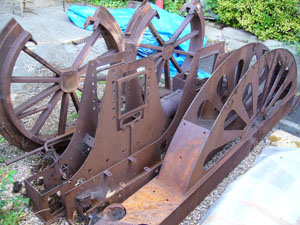Robert Nemeth on Brighton’s Ghost Train

Nearly 40 years have passed since Brighton Station’s lower goods yard – and its relatively narrow access bridge – have been used as they were intended. With this in mind, passers-by are in for a shock when they look up at the narrow Grade II Listed bridge above New England Road.
It was eight years ago, that developer Chris Gilbert of QED called for ideas for public artworks to decorate his New England Quarter redevelopment scheme. Several suggestions from metal-mad local craftsman, and Austin 7 Special owner, Jon Mills, were implemented including mounting large steel models of ‘clinker-shovels’ and other tools on the even larger brick pillars that once held up sections of Brighton’s nationally-renowned locomotive works.

In consistency with much of what Brighton experiences when it comes to trains, the process of installing the ‘Jenny Lind’ or, as I prefer it, the ‘Ghost Train’ on the bridge was somewhat slow. I can only imagine the bureaucracy that was involved in requesting permission to install the steel train silhouette on Network Rail’s Grade II Listed cast iron bridge. The structure dates from 1852, was fabricated in Brighton’s Regent Foundry, and is no doubt rather fragile.
“The Ghost Train appears to sit on a bridge but it’s actually fixed to a cantilevered beam”
An 11m-long 1.5-tonne steel beam was the solution. The train appears to sit on the bridge but it’s actually fixed to a cantilevered beam. The beam sits a few inches above the ground with its concrete foundations in terra firma to the south side of the bridge. Jon employed a variety of techniques to create the Ghost Train including laser and plasma cutting for crisp and rough cuts respectively. Most of the work was actually carried out three years ago in Jon’s hidden workshop near Preston Park Station (a future column topic no doubt). Once the go-ahead was given, all of the slowly rusting pieces were shot-blasted and sprayed with zinc prior to undergoing powder-coating for a perfect finish.
Jenny Lind was a Swedish opera singer and namesake of the first of a class of ten steam locomotives that were built for the London, Brighton & South Coast Railway in 1847. The class was so successful that 60 more locomotives were built for various railway companies around the country. The name ‘Jenny Lind’ came to be adopted for the whole class.
Jenny Lind herself actually performed in Brighton in 1848 in what is thought was going to be her last concert. It’s a delight that she’s back.
www.buildingopinions.com
robert@buildingopinions.com
Follow me: @robert_nemeth




















